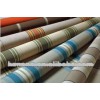1.Very safe
2. High performance to resist fire
3.Ecofriendly and no smell
Fire resistant agent for texitle
Introduction of Flame retardant :
A flame retardant is a substance other than water that reduces flammability of fuels or delays their combustion. This typically refers to chemical retardants but may also include substances that work by physical action, such as cooling the fuels; examples of these include fire-fighting foams and fire-retardant gels. The name fire retardant may also be applied to substances used to coat an object,such as a spray retardant to prevent Christmas trees from burning.Fire retardants are commonly used in fire fighting.
Flame Retardant Finishing process on Textile Materials like Textile Cotton, Polyester fiber and fabrics:
The burning cycle of polymeric material consist of 3 steps which is shown below-
If a polymeric material is caught by fire, the polymer absorb heat and melts which is the 1st step (Condensed solid phase) leads to volatile pyrolysis products which has relatively low molecular weight.
In steps 2, this volatile products are oxidized with the air, O2, N2O and continuous to burn with giving up heat and finally gives rise to flame.
In steps 3, the heat is transferred from the oxidation products to the polymeric material which acts as fuel and the burning continues.
The burning cycle thus continues until the polymeric material is finished provided that there is no interruption in the three stages. The burning cycle may be utilized to design for flame retardency of textile fibers/fabrics/garments by the following ways-
- Flame retardancy can be done by interrupting the 1st step by using agents which will produce char rather than tar. The car is flame retardant. This technique is suitable for wool and cotton but not suitable for polyester.
- Flame retardancy can be done by interrupting the 2nd step by using bromine which slows down the free radical combustion reaction velocity. This technique is applicable for polyester because it does form char. This technique is applicable is not so effective as technique A
- Flame Retardant can be done by interrupting the step 3 by using heat absorbing materials for example alumina tri-hydrate. This is the least effective method.
Advantages of Flame resistant agent for texitle:
1.Very safe
2. High performance to resist fire
3.Ecofriendly and no smell
Our other textile auxiliary as follow:
| Seq | Product | Code |
| 1 | Textile nano silver antimicrobial agent | AGS-F-1 |
| 2 | Textile antimicrobial agent | JK-F-1 |
| 3 | Textile oil,water and dust proof agent | HZR-003 |
| 4 | Textile anti-mite agent | HZ-FM002 |
| 5 | Chemical fibre durable flame-retardant agent | HZ-CU003 |
| 6 | Textile aromatic capsule agent | HZ-JN001 |
| 7 | Textile mildew-resistant agent | FM-001 |
| 8 | Textile anti-formaldehyde agent | HZ-CH20 |
| 9 | Textile anion agent | ARS-WF010 |
| 10 | Textile far-infrared agent | HZ-YH010 |
| 11 | Nano silver aroma degout agent | AGS-WMF1000C |
| 12 | Nano silver ultraviolet-proof agent | ZWQ-1 |
| 13 | Aloe collagen moisturizer | HZ-LH001 |
| 14 | Leather mildew-resistant agent | PM-002 |
| 15 | Cotton anti-wrinkle agent | MKZ-020 |
| 16 | Down nano silver antimicrobial agent | AGS-YR001 |
| 17 | Textile easy dirt-proof agent | EQW-020 |
| 18 | Textile hygroscopic and perspiration agent | XS-002 |
| 19 | Textile multi-function agent | KFY-F001 |
| 20 | Textile multi-function agent | KSZ-F002 |
| 21 | Textile antistatic agent | YJ-FJ002 |
| 22 | Mono nano silver antimicrobial plastic | AGS-DMB5000 |
| 23 | Silver zirconium phosphate antimicrobial | AGS-ZMB6000 |
| 24 | Anion plastic master batch | ARP-MB020 |
| 25 | Far- infrared plastic master batch | YHP-MB020 |
| 26 | Charry bamboo plastic master batch | ZT-M020 |
| 27 | Antistatic plastic master batch | C-MB020 |
| 28 | Inorganic silver antimicrobial powder | AGP-ZP003 |
| 29 | Inorganic nano silver antimicrobial powder | AGP-AP002 |
| 30 | Nano anion powder | CRT-P200 |
| 31 | Nano far infrared powder | CYH-P100 |
| 32 | Nano charry bamboo powder | CZT-P100 |








